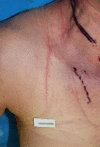Lightning and the Forensic Pathologist
- PMID: 31240028
- PMCID: PMC6474460
- DOI: 10.23907/2018.007
Lightning and the Forensic Pathologist
Abstract
This paper explores the pathology caused by lightning. It covers the basic physics and mechanisms of injury of lightning strikes followed by a short discussion. The purpose of this paper is to suggest an approach to the investigation and autopsy of a lightning-related death.
Keywords: Autopsy; Forensic pathology; Keraunopathology; Lightning; Postmortem.
Conflict of interest statement
DISCLOSURES & DECLARATION OF CONFLICTS OF INTEREST The authors, reviewers, editors, and publication staff do not report any relevant conflicts of interest
Figures









References
-
- Critchely M. Neurological effects of lightning and of electricity. Lancet. 1934. Jan 13; 223(5759): 68–72.
-
- Uman M.A. Lightning. New York: McGraw-Hill; c1969. Chapter 1, Introduction to lightning; p. 1–13.
-
- Rakov V.A., Uman M.A. Lightning: physics and effects. New York: Cambridge University Press; c2003: Chapter 11, Thunder; p. 378, 387.
Publication types
LinkOut - more resources
Full Text Sources
